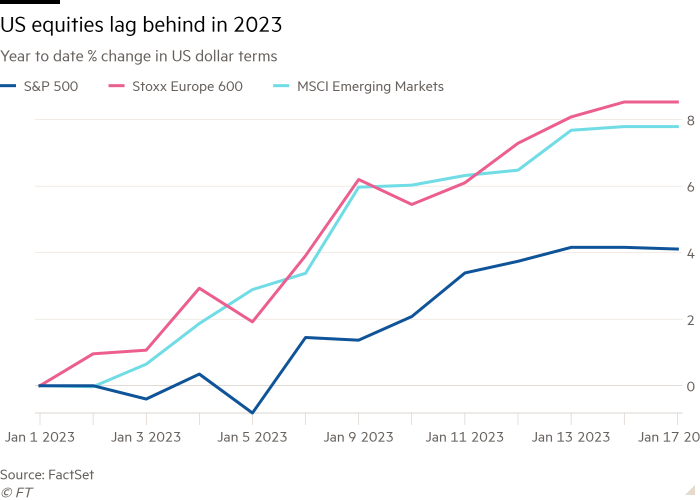Wall Street has fallen out of favour with global fund managers who have cut allocations to the US stock market to their lowest level for 17 years to hunt for opportunities in Europe and emerging market equities.
The Bank of America global fund managers survey showed a net 39 per cent of asset allocators held an “underweight” position in US stocks in January, up from 12 per cent in December, in the most abrupt collapse in sentiment in a single month in the history of the closely followed report, which began in 1985.
The darkening outlook for US stocks underscores a significant shift in global markets. Wall Street equities were in vogue during the pandemic-era bull market that was sparked by massive stimulus deployed by the Federal Reserve and US government to combat the coronavirus crisis.
Tech titans like Apple, Microsoft and Google owner Alphabet, as well as electric-car maker Tesla and chipmaker Nvidia, posted huge gains from the market lows in 2020. Wall Street’s rally reversed sharply last year, with the broad S&P 500 falling by almost a fifth as the Fed began reining in the measures that lifted markets.

Now, more than half of the 253 fund managers, who oversee combined assets of $710bn, said they expected the S&P 500 to trade below the 4,000 points level at the end of this year while 37 per cent predicted that the main US stock market benchmark would close out 2023 above that mark. It traded at about 4,010 on Tuesday.
Michael Wilson, an equity strategist at investment bank Morgan Stanley, who has issued multiple warnings about the outlook for US stocks, said corporate earnings and profit margins were “likely to significantly disappoint whether there was an economic recession or not”.
“The main culprit is the elevated and volatile inflationary environment which is likely to play havoc with profitability,” said Wilson.
Jamie Fahy, a global strategist at Citi, said that the US equity market “will suffer” if the technology sector started to see more downgrades for earnings.
Major investment banks’ year-end 2023 forecasts for the S&P 500, made in December, ranged from a high of 4,500 by Deutsche Bank to a low of 3,400 by BNP Paribas.
The S&P 500 has risen 4.1 per cent this year, but that has trailed Europe’s Stoxx 600, which has gained 8.5 per cent in US dollar terms and MSCI’s emerging markets index, which is up 7.8 per cent on the same basis.
Most investors believe the peak for global inflation has already passed, which has also led to a slight moderation in fears about a recession, according to the BofA poll.
Fewer of the participants in BofA’s survey expect that the US central bank will have to raise the key Fed funds interest rate as high as 5.25 per cent or more this year. The proportion of respondents expecting US rates to hit that mark dropped from 44 per cent in December to 20 per cent this month. A peak of 5 per cent for the main US policy rate is now seen as the most likely outcome by the majority of global fund managers, from a range of 4.25 to 4.50 per cent currently.
“Large investors are saying for the first time since March 2020 that monetary policy is too tight. They are telling central banks that the monetary tightening cycle has worked too well and it is now time to stop [raising interest rates],” said Michael Hartnett, chief investment strategist at BofA global research.
The pivot by global fund managers away from the US has been mirrored by a shift into Europe and emerging markets.
Just over a quarter of global fund managers are now “overweight” in emerging markets. These large institutional investors have also flipped their allocation to European equities from net 10 per cent underweight in December to 4 per cent overweight in January. Investors are described as overweight when they allocate a larger share to a region than its weighting in a benchmark index which can be used to assess a fund manager’s performance.




